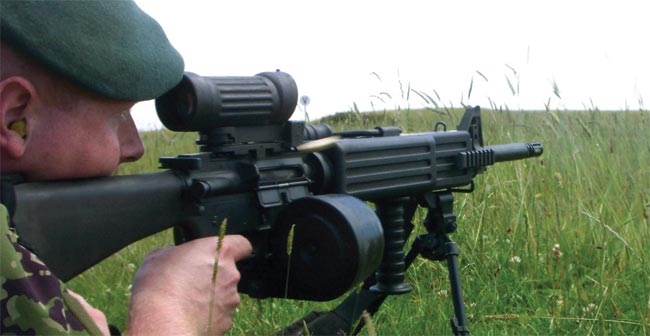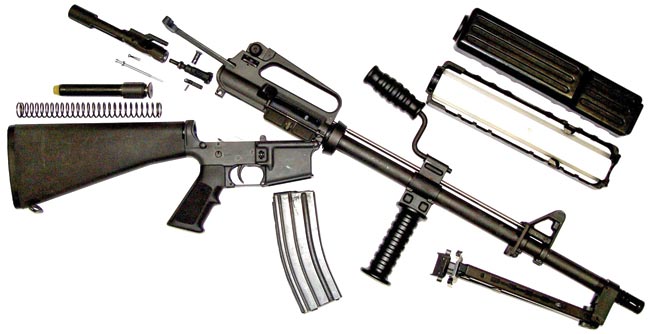Other Modifications: Creating the Colt LMG
Colt’s Stanley Silsby and Henry Tatro developed a hydraulic buffer which slowed down the cyclic rate of the M16-family of weapons back in the mid 1970s. The project lay dormant until the development of the LMG. This hydraulic buffer decreased the rate of fire from 700-950 rounds per minute to 600-750 rounds per minute. Not only does the lower cyclic rate increase accuracy but it also conserves ammunition and helps to extend the barrel life.
The description of the function of the hydraulic buffer is best described as written in the patent:
“A recoil assembly of the invention includes a buffer having a tubular housing sealed at the rear end by a bumper adapter to engage the end of the receiver extension and by a piston at the front end adapted to engage the a reciprocating bolt and carrier assembly. A spring, seated upon the bumper, urges a sliding seal in a forward direction. The volume between the seal and the piston is filled with hydraulic fluid and contains an orifice, fixedly mounted in the housing for furnishing hydraulic resistance to movement of the piston.
“…the buffer travels with the end of the operating spring which is seated against the flange thereof. At the end of the recoil stroke, the momentum of the bolt and carrier assembly causes depression of the piston from its original extended, thereby increasing the time interval of the recoil stroke. During the return stroke, the spring loaded seal within the buffer pushes fluid through the orifice in the opposite direction, thereby to return the piston to its original position. Since the buffer of the invention has its interior volume between the seal and the pistol filled with fluid, hydraulic resistance commences as soon as the piston is displaced.”


Part of the job of a light machine gun is to put down heavy and accurate sustained fire. That fire may be at personnel or at area targets. Henry Tatro felt the standard field sights were insufficient for the task so he redesigned the rear sight. The rear sight’s main difference was that it would be fully adjustable for both windage and elevation. Tatro developed a separate rear sight base whereas elevation is adjusted by a dial under the base. He also felt there should be an easier way to adjust the rear sight rather than using a bullet tip. He designed a windage adjustment knob eliminating the need for a projectile or tool to be used to change the windage of the weapon. This design eventually was chosen and utilized on the M16A2 and continues on the detachable carrying handles for M16A4 rifles and M4 carbines today.
As previously stated, Colt developed heavy barrel versions of the M16-family of weapons in the early 1960s; however, not like this. The barrel of the LMG was significantly thicker with an overall diameter on nearly one inch. New handguards were developed that were square in shape and also interchangeable with no separate left and right handguard. Due to increased weight, an FN-FAL style carrying handle was added to the top of the middle of the barrel. An M60 bipod was also added. There was no forward assist due to its open bolt operation.
Left in the Depths of the Colt Model Shop
At the time the LMG was developed, the Colt workforce was entrenched in a lengthy and continuous strike. The LMG remained in a prototype stage and due to other priorities Tatro went to work on the M16A2 development. There were no time, money or product development teams available to complete the project and get it into production.

The LMG’s Second Breath from Canada
During this turbulent time Colt had entered into a licensing agreement with the Canadian government to manufacture M16A2-varients for the Canadian Forces. The manufacturer chosen by the Canadian Forces was Diemaco, a division of Herouex Devtek of Kitchener, Ontario. Diemaco was much smaller than Colt and had a first-class design team. They had ideal conditions at the time to take a product under development and get it ready for production. Phil O’Dell and Ian Anderson went to the Hartford plant to look at the LMG and agreed the Diemaco Product Engineering Department would take on the task. Under license of Colt, Diemaco would devote the engineering resources, fixturing costs and testing costs necessary to move the LMG into production.
Like the Canadian C7 and C8 weapons, Diemaco would use their proprietary hammer forged barrels for the LMG. The diameter of the barrel was changed to accept the newly developed yoke, which the carrying handle and vertical pistol grip would be attached. Diemaco also redesigned the bipod to have adjustable legs. Several design enhancements were added to the LMG from the fruits of M16A2 development including the new finger groove pistol grip, re-enforced lower receiver, the integral fired cartridge case deflector (Brunton Bump) as well as the use of the new canted delta ring to make it easier to remove the handguards. Another very interesting change made by Diemaco was the redesign of the gas tube. Due to the increase in sustained rate of fire, the gas tube had to be modified by increasing both the inside and outside diameter of the gas tube. This helped deal with heat as the larger internal diameter increased the internal volume of gas, which lowered the temperature and operating pressure within the carrier.
The final design was completed and put into production in the winter of 1987 and early 1988. This first model was the M16A2 LMG (R0750). This weapon was made completely in Canada for Diemaco sales and the upper receiver and fire control parts were provided to Colt and Colt utilized Colt marked lower receivers for weapons to be sold by Colt.
An updated version was introduced as the CAR or Colt Automatic Rifle (R0750MC) in 2001. This model eliminated the carrying handle in favor of a flat top upper receiver and a mounting lug for a bayonet was added to the barrel. The TRI-AD I twin rail attachment was added to the front sight assembly that enabled accessories to be mounted as well as two sling attachment points one either side of the rifle. Another yoke was added to the barrel for a mounting lug for the removable bipod.
A vast majority of these weapons were sold by Diemaco (or now Colt Canada). Diemaco called these weapons the LSW (Light Support Weapon) instead of the LMG. The LSW was sold to Denmark and the Royal Dutch Marines. The main difference between the LSW was that it fired from the closed bolt and had forward assist assemblies. The countries who procured these weapons wanted semi as well as automatic fire.
The LMG/LSW is a very versatile weapon. The higher weight plus the hydraulic buffer make this an extremely accurate and reliable weapon though the weapon was never sold in large quantities. Up to now, preference has been the belt fed SAW. However, with the IAR program brought out by the Marine Corps for magazine fed sustained fire weapons, the concept may return by demand. Although the LMG was discontinued from Colt Defense LLC in late 2008, the ball was picked up by Colt’s newly introduced Infantry Automatic Rifle (IAR6940) – but that is another story.








